Global Meta-Analysis of Nitrate Leaching Vulnerability in Synthetic and Organic Fertilizers over the Past Four Decades
Abstract
:1. Introduction
2. Materials and Methods
2.1. Search Criteria through Online Research Databases and Study Selection
- Chemical (synthetic) or organic fertilizers must have been used in each study.
- At least one fertilizer application rate must have been mentioned.
- NO3−-N leaching must have been monitored.
2.2. Meta-Analysis
3. Results
3.1. Effect of Fertilizer Type on NO3−-N Leaching as a Function of Crop Type
3.2. Effect of Nitrogen Source on NO3−-N Leaching
3.3. Effect of Fertilizer Type on NO3−-N Leaching as a Function of Soil Properties
3.4. Effect of Fertilizer Type on NO3−-N Leaching as a Function of Measuring Method
4. Discussion
5. Conclusions
Funding
Data Availability Statement
Conflicts of Interest
References
- Jenkinson, D.S. The impact of humans on the nitrogen cycle, with focus on temperate arable agriculture. Plant Soil 2001, 228, 3–15. [Google Scholar] [CrossRef]
- Govindasamy, P.; Muthusamy, S.K.; Bagavathiannan, M.; Mowrer, J.; Jagannadham, P.T.K.; Maity, A.; Halli, H.M.; Sujayanand, G.K.; Vadivel, R.; Das, T.K.; et al. Nitrogen use efficiency—A key to enhance crop productivity under a changing climate. Front. Plant Sci. 2023, 14, 1121073. [Google Scholar] [CrossRef]
- Giordano, M.; Petropoulos, S.A.; Rouphael, Y. The Fate of Nitrogen from Soil to Plants: Influence of Agricultural Practices in Modern Agriculture. Agriculture 2021, 11, 944. [Google Scholar] [CrossRef]
- Ongley, E.D.; Xiaolan, Z.; Tao, Y. Current status of agricultural and rural non-point source Pollution assessment in China. Environ. Pollut. 2010, 158, 1159–1168. [Google Scholar] [CrossRef]
- Kitchen, N.R.; Goulding, K.W.T.; Shanahan, J.F. Chapter 15—Proven Practices and Innovative Technologies for On-Farm Crop Nitrogen Management. In Nitrogen in the Environment, 2nd ed.; Hatfield, J.L., Follett, R.F., Eds.; Academic Press: San Diego, CA, USA, 2008; pp. 483–517. [Google Scholar]
- FAOSTATS. FAOSTAT Statistics Database. Available online: https://www.fao.org/faostat (accessed on 2 August 2022).
- Schröder, J.J.; Scholefield, D.; Cabral, F.; Hofman, G. The effects of nutrient losses from agriculture on ground and surface water quality: The position of science in developing indicators for regulation. Environ. Sci. Policy 2004, 7, 15–23. [Google Scholar] [CrossRef]
- Zhai, Y.; Zhao, X.; Teng, Y.; Li, X.; Zhang, J.; Wu, J.; Zuo, R. Groundwater Nitrate Pollution and Human Health Risk Assessment by using HHRA Model in an Agricultural Area, NE China. Ecotoxicol. Environ. Saf. 2017, 137, 130–142. [Google Scholar] [CrossRef]
- Di, H.J.; Cameron, K.C. Nitrate leaching in temperate agroecosystems: Sources, factors and mitigating strategies. Nutr. Cycl. Agroecosystems 2002, 64, 237–256. [Google Scholar] [CrossRef]
- Dalgaard, T.; Bienkowski, J.F.; Bleeker, A.; Dragosits, U.; Drouet, J.L.; Durand, P.; Frumau, A.; Hutchings, N.J.; Kedziora, A.; Magliulo, V.; et al. Farm Nitrogen Balances in six European landscapes as an Indicator for Nitrogen losses and Basis for Improved Management. Biogeosciences 2012, 9, 5303–5321. [Google Scholar] [CrossRef]
- Nolan, B.T.; Stoner, J.D. Nutrients in Groundwaters of the Conterminous United States, 1992–1995. Environ. Sci. Technol. 2000, 34, 1156–1165. [Google Scholar] [CrossRef]
- Li, T.; Hao, X.; Kang, S. Spatial Variability of Grape Yield and Its Association with Soil Water Depletion Within A Vineyard of Arid Northwest China. Agric. Water Manag. 2017, 179, 158–166. [Google Scholar] [CrossRef]
- Cameron, K.C.; Di, H.J.; Moir, J.L. Nitrogen losses from the soil/plant system: A review. Ann. Appl. Biol. 2013, 162, 145–173. [Google Scholar] [CrossRef]
- Padilla, F.M.; Gallardo, M.; Manzano-Agugliaro, F. Global trends in nitrate leaching research in the 1960–2017 period. Sci. Total Environ. 2018, 643, 400–413. [Google Scholar] [CrossRef] [PubMed]
- Sieling, K.; Kage, H. N balance as an indicator of N leaching in an oilseed rape—Winter wheat—Winter barley rotation. Agric. Ecosyst. Environ. 2006, 115, 261–269. [Google Scholar] [CrossRef]
- Thomsen, I.K.; Lægdsmand, M.; Olesen, J.E. Crop growth and nitrogen turnover under increased temperatures and low autumn and winter light intensity. Agric. Ecosyst. Environ. 2010, 139, 187–194. [Google Scholar] [CrossRef]
- Shrestha, R.K.; Cooperband, L.R.; MacGuidwin, A.E. Strategies to reduce nitrate leaching into groundwater in potato grown in sandy soils: Case study from North Central USA. Am. J. Potato Res. 2010, 87, 229–244. [Google Scholar] [CrossRef]
- Hansen, B.; Kristensen, E.; Grant, R.; Høgh-Jensen, H.; Simmelsgaard, S.E.; Olesen, J.E. Nitrogen leaching from conventional versus organic farming systems—A systems modelling approach. Eur. J. Agron. 2000, 13, 65–82. [Google Scholar] [CrossRef]
- Stopes, C.; Lord, E.I.; Philipps, L.; Woodward, L. Nitrate leaching from organic farms and conventional farms following best practice. Soil Use Manag. 2002, 18, 256–263. [Google Scholar] [CrossRef]
- Torstensson, G.; Aronsson, H.; Bergström, L. Nutrient Use Efficiencies and Leaching of Organic and Conventional Cropping Systems in Sweden. Agron. J. 2006, 98, 603–615. [Google Scholar] [CrossRef]
- Sapkota, T.B.; Askegaard, M.; Lægdsmand, M.; Olesen, J.E. Effects of catch crop type and root depth on nitrogen leaching and yield of spring barley. Field Crops Res. 2012, 125, 129–138. [Google Scholar] [CrossRef]
- Kirchmann, H.; Bergström, L. Do organic farming practices reduce nitrate leaching? Commun. Soil Sci. Plant Anal. 2001, 32, 997–1028. [Google Scholar] [CrossRef]
- Mondelaers, K.; Aertsens, J.; Van Huylenbroeck, G. A meta-analysis of the differences in environmental impacts between organic and conventional farming. Br. Food J. 2009, 111, 1098–1119. [Google Scholar] [CrossRef]
- Korsaeth, A. Relations between nitrogen leaching and food productivity in organic and conventional cropping systems in a long-term field study. Agric. Ecosyst. Environ. 2008, 127, 177–188. [Google Scholar] [CrossRef]
- Benoit, M.; Garnier, J.; Anglade, J.; Billen, G. Nitrate leaching from organic and conventional arable crop farms in the Seine Basin (France). Nutr. Cycl. Agroecosyst. 2014, 100, 285–299. [Google Scholar] [CrossRef]
- Quemada, M.; Baranski, M.; Nobel-de Lange, M.N.J.; Vallejo, A.; Cooper, J.M. Meta-analysis of strategies to control nitrate leaching in irrigated agricultural systems and their effects on crop yield. Agric. Ecosyst. Environ. 2013, 174, 1–10. [Google Scholar] [CrossRef]
- Boy-Roura, M.; Cameron, K.C.; Di, H.J. Identification of nitrate leaching loss indicators through regression methods based on a meta-analysis of lysimeter studies. Environ. Sci. Pollut. Res. 2016, 23, 3671–3680. [Google Scholar] [CrossRef]
- Wang, Y.; Ying, H.; Yin, Y.; Zheng, H.; Cui, Z. Estimating soil nitrate leaching of nitrogen fertilizer from global meta-analysis. Sci. Total Environ. 2019, 657, 96–102. [Google Scholar] [CrossRef]
- Li, Z.J.; Reichel, R.; Xu, Z.F.; Vereecken, H.; Brüggemann, N. Return of crop residues to arable land stimulates NO emission but mitigates NO leaching: A meta-analysis. Agron. Sustain. Dev. 2021, 41, 66. [Google Scholar] [CrossRef]
- Gardner, J.B.; Drinkwater, L.E. The fate of nitrogen in grain cropping systems: A meta-analysis of 15N field experiments. Ecol. Appl. 2009, 19, 2167–2184. [Google Scholar] [CrossRef]
- Xia, L.; Lam, S.K.; Chen, D.; Wang, J.; Tang, Q.; Yan, X. Can knowledge-based N management produce more staple grain with lower greenhouse gas emission and reactive nitrogen pollution? A meta-analysis. Glob. Chang. Biol. 2017, 23, 1917–1925. [Google Scholar] [CrossRef]
- Xia, L.; Lam, S.K.; Yan, X.; Chen, D. How Does Recycling of Livestock Manure in Agroecosystems Affect Crop Productivity, Reactive Nitrogen Losses, and Soil Carbon Balance? Environ. Sci. Technol. 2017, 51, 7450–7457. [Google Scholar] [CrossRef]
- Qasim, W.; Xia, L.; Lin, S.; Wan, L.; Zhao, Y.; Butterbach-Bahl, K. Global greenhouse vegetable production systems are hotspots of soil N2O emissions and nitrogen leaching: A meta-analysis. Environ. Pollut. 2021, 272, 116372. [Google Scholar] [CrossRef]
- Ren, F.; Sun, N.; Misselbrook, T.; Wu, L.; Xu, M.; Zhang, F.; Xu, W. Responses of crop productivity and reactive nitrogen losses to the application of animal manure to China’s main crops: A meta-analysis. Sci. Total Environ. 2022, 850, 158064. [Google Scholar] [CrossRef]
- Liberati, A.; Altman, D.G.; Tetzlaff, J.; Mulrow, C.; Gøtzsche, P.C.; Ioannidis, J.P.; Clarke, M.; Devereaux, P.J.; Kleijnen, J.; Moher, D. The PRISMA statement for reporting systematic reviews and meta-analyses of studies that evaluate health care interventions: Explanation and elaboration. BMJ 2009, 339, b2700. [Google Scholar] [CrossRef]
- Moher, D.; Liberati, A.; Tetzlaff, J.; Altman, D.G.; The, P.G. Preferred reporting items for systematic reviews and meta-analyses: The PRISMA statement. PLoS Med. 2009, 6, e1000097. [Google Scholar] [CrossRef]
- Harrer, M.; Cuijpers, P.; Furukawa, T.A.; Ebert, D.D. Doing Meta-Analysis with R: A Hands-On Guide, 1st ed.; Chapman & Hall/CRC Press: Boca Raton, FL, USA; London, UK, 2021. [Google Scholar]
- Schwarzer, G. Meta: An R package for meta-analysis. R News 2007, 7, 40–45. [Google Scholar]
- Viechtbauer, W. Conducting Meta-Analyses in R with the metafor Package. J. Stat. Softw. 2010, 36, 48. [Google Scholar] [CrossRef]
- Cochran, W.G. The Combination of Estimates from Different Experiments. Biometrics 1954, 10, 101–129. [Google Scholar] [CrossRef]
- Hartung, J.; Knapp, G. A refined method for the meta-analysis of controlled clinical trials with binary outcome. Stat. Med. 2001, 20, 3875–3889. [Google Scholar] [CrossRef] [PubMed]
- Wickham, H. Ggplot2: Elegant Graphics for Data Analysis; Springer: New York, NY, USA, 2011. [Google Scholar]
- Augé, R.M.; Toler, H.D.; Saxton, A.M. Arbuscular mycorrhizal symbiosis and osmotic adjustment in response to NaCl stress: A meta-analysis. Front. Plant Sci. 2014, 5, 562. [Google Scholar] [CrossRef] [PubMed]
- Galloway, J.; Dentener, F.; Boyer, E.; Howarth, R.; Seitzinger, S.; Asner, G.; Cleveland, C.; Green, P.; Holland, E.; Karl, D.; et al. Nitrogen Cycles: Past, Present, and Future. Biogeochemistry 2004, 70, 153–226. [Google Scholar] [CrossRef]
- Dahan, O.; Babad, A.; Lazarovitch, N.; Russak, E.E.; Kurtzman, D. Nitrate leaching from intensive organic farms to groundwater. Hydrol. Earth Syst. Sci. 2014, 18, 333–341. [Google Scholar] [CrossRef]
- Demurtas, C.E.; Seddaiu, G.; Ledda, L.; Cappai, C.; Doro, L.; Carletti, A.; Roggero, P.P. Replacing organic with mineral N fertilization does not reduce nitrate leaching in double crop forage systems under Mediterranean conditions. Agric. Ecosyst. Environ. 2016, 219, 83–92. [Google Scholar] [CrossRef]
- Pandey, A.; Li, F.C.; Askegaard, M.; Rasmussen, I.A.; Olesen, J.E. Nitrogen balances in organic and conventional arable crop rotations and their relations to nitrogen yield and nitrate leaching losses. Agr. Ecosyst. Environ. 2018, 265, 350–362. [Google Scholar] [CrossRef]
- Doltra, J.; Olesen, J.E. The role of catch crops in the ecological intensification of spring cereals in organic farming under Nordic climate. Eur. J. Agron. 2013, 44, 98–108. [Google Scholar] [CrossRef]
- Haraldsen, T.K.; Andersen, U.; Krogstad, T.; Sørheim, R. Liquid digestate from anaerobic treatment of source-separated household waste as fertilizer to barley. Waste Manag. Res. 2011, 29, 1271–1276. [Google Scholar] [CrossRef] [PubMed]
- Karhu, K.; Kalu, S.; Seppänen, A.; Kitzler, B.; Virtanen, E. Potential of biochar soil amendments to reduce N leaching in boreal field conditions estimated using the resin bag method. Agric. Ecosyst. Environ. 2021, 316, 107452. [Google Scholar] [CrossRef]
- Santos, A.; Fangueiro, D.; Moral, R.; Bernal, M.P. Composts Produced From Pig Slurry Solids: Nutrient Efficiency and N-Leaching Risks in Amended Soils. Front. Sustain. Food Syst. 2018, 2, 8. [Google Scholar] [CrossRef]
- Pimentel, D.; Hepperly, P.; Hanson, J.; Douds, D.; Seidel, R. Environmental, Energetic, and Economic Comparisons of Organic and Conventional Farming Systems. BioScience 2005, 55, 573–582. [Google Scholar] [CrossRef]
- Zhang, J.; He, P.; Ding, W.; Ullah, S.; Abbas, T.; Li, M.; Ai, C.; Zhou, W. Identifying the critical nitrogen fertilizer rate for optimum yield and minimum nitrate leaching in a typical field radish cropping system in China. Environ. Pollut. 2021, 268, 115004. [Google Scholar] [CrossRef]
- Jiang, Y.; Nyiraneza, J.; Khakbazan, M.; Geng, X.; Murray, B.J. Nitrate leaching and potato yield under varying plow timing and nitrogen rate. Agrosyst. Geosci. Environ. 2019, 2, 1–14. [Google Scholar] [CrossRef]
- Wilson, M.L.; Rosen, C.J.; Moncrief, J.F. Effects of polymer-coated urea on nitrate leaching and nitrogen uptake by potato. J. Environ. Qual. 2010, 39, 492–499. [Google Scholar] [CrossRef] [PubMed]
- Valkama, E.; Rankinen, K.; Virkajärvi, P.; Salo, T.; Kapuinen, P.; Turtola, E. Nitrogen fertilization of grass leys: Yield production and risk of N leaching. Agric. Ecosyst. Environ. 2016, 230, 341–352. [Google Scholar] [CrossRef]
- Puetz, T.; Schilling, J.; Vereecken, H. The influence of the lysimeter filling on the soil monolith inside. In Proceedings of the EGU General Assembly, Vienna, Austria, 19–24 April 2009; p. 10089. [Google Scholar]
- Meissner, R.; Rupp, H.; Haselow, L. Use of lysimeters for monitoring soil water balance parameters and nutrient leaching. In Climate Change and Soil Interactions; Elsevier: Amsterdam, The Netherlands, 2020; pp. 171–205. [Google Scholar]
- Wang, Q.; Cameron, K.; Buchan, G.; Zhao, L.; Zhang, E.H.; Smith, N.; Carrick, S. Comparison of lysimeters and porous ceramic cups for measuring nitrate leaching in different soil types. N. Z. J. Agric. Res. 2012, 55, 333–345. [Google Scholar] [CrossRef]
- Khodabin, G.; Lightburn, K.; Hashemi, S.M.; Moghada, M.S.K.; Jalilian, A. Evaluation of nitrate leaching, fatty acids, physiological traits and yield of rapeseed (Brassica napus) in response to tillage, irrigation and fertilizer management. Plant Soil 2022, 473, 423–440. [Google Scholar] [CrossRef]
- Defra. Diffuse Nitrate Pollution from Agriculture-Strategies for Reducing Nitrate Leaching; Defra: London, UK, 2007. [Google Scholar]
- Zheng, J.; Qu, Y.; Kilasara, M.M.; Mmari, W.N.; Funakawa, S. Nitrate leaching from the critical root zone of maize in two tropical highlands of Tanzania: Effects of fertilizer-nitrogen rate and straw incorporation. Soil Tillage Res. 2019, 194, 104295. [Google Scholar] [CrossRef]
- Alam, S.M.; Naqvi, S.S.M.; Ansari, R. Impact of soil pH on nutrient uptake by crop plants. In Handbook of Plant and Crop Stress; Marcel Dekker, Inc.: New York, NY, USA, 1999; Volume 2, pp. 51–60. [Google Scholar]
- Cao, H.; Chen, R.; Wang, L.; Jiang, L.; Yang, F.; Zheng, S.; Wang, G.; Lin, X. Soil pH, total phosphorus, climate and distance are the major factors influencing microbial activity at a regional spatial scale. Sci. Rep. 2016, 6, 25815. [Google Scholar] [CrossRef] [PubMed]
- Wang, C.; Lv, J.; Coulter, J.A.; Xie, J.; Yu, J.; Li, J.; Zhang, J.; Tang, C.; Niu, T.; Gan, Y. Slow-Release Fertilizer Improves the Growth, Quality, and Nutrient Utilization of Wintering Chinese Chives (Allium tuberosum Rottler ex Spreng.). Agronomy 2020, 10, 381. [Google Scholar] [CrossRef]
- Weil, R.; Brady, N. The Nature and Properties of Soils, 15th ed.; Pearson: London, UK, 2017. [Google Scholar]
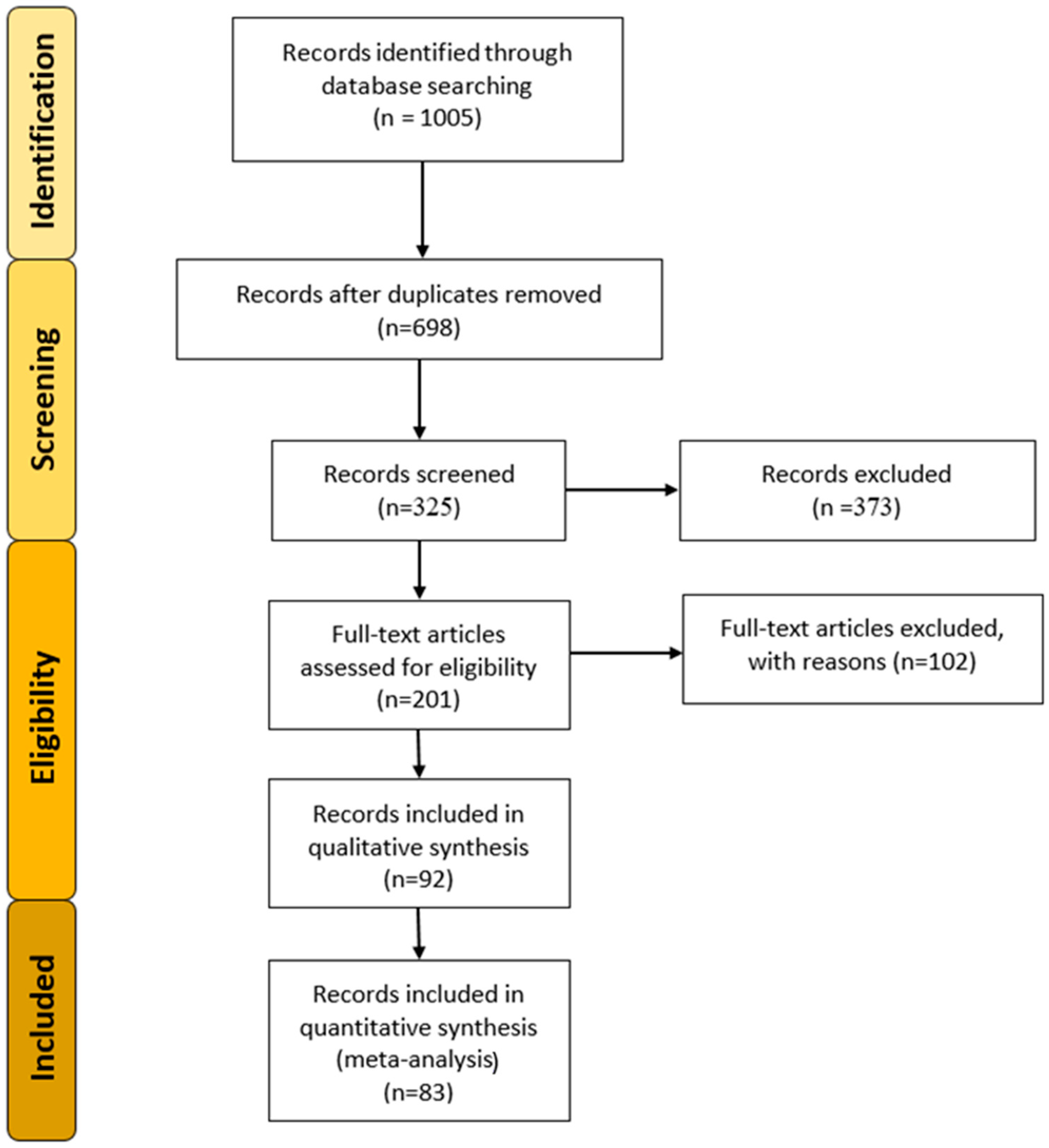
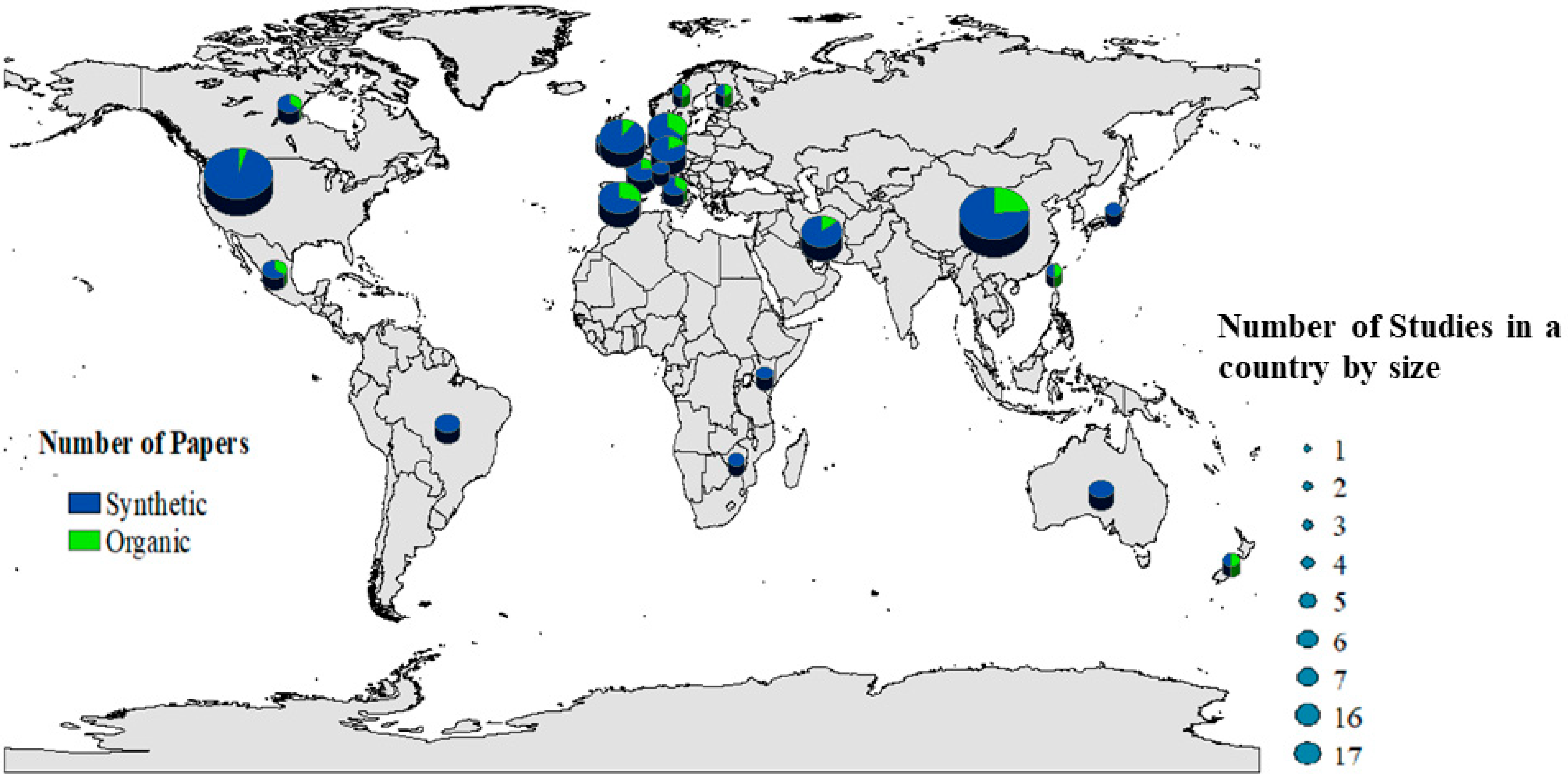
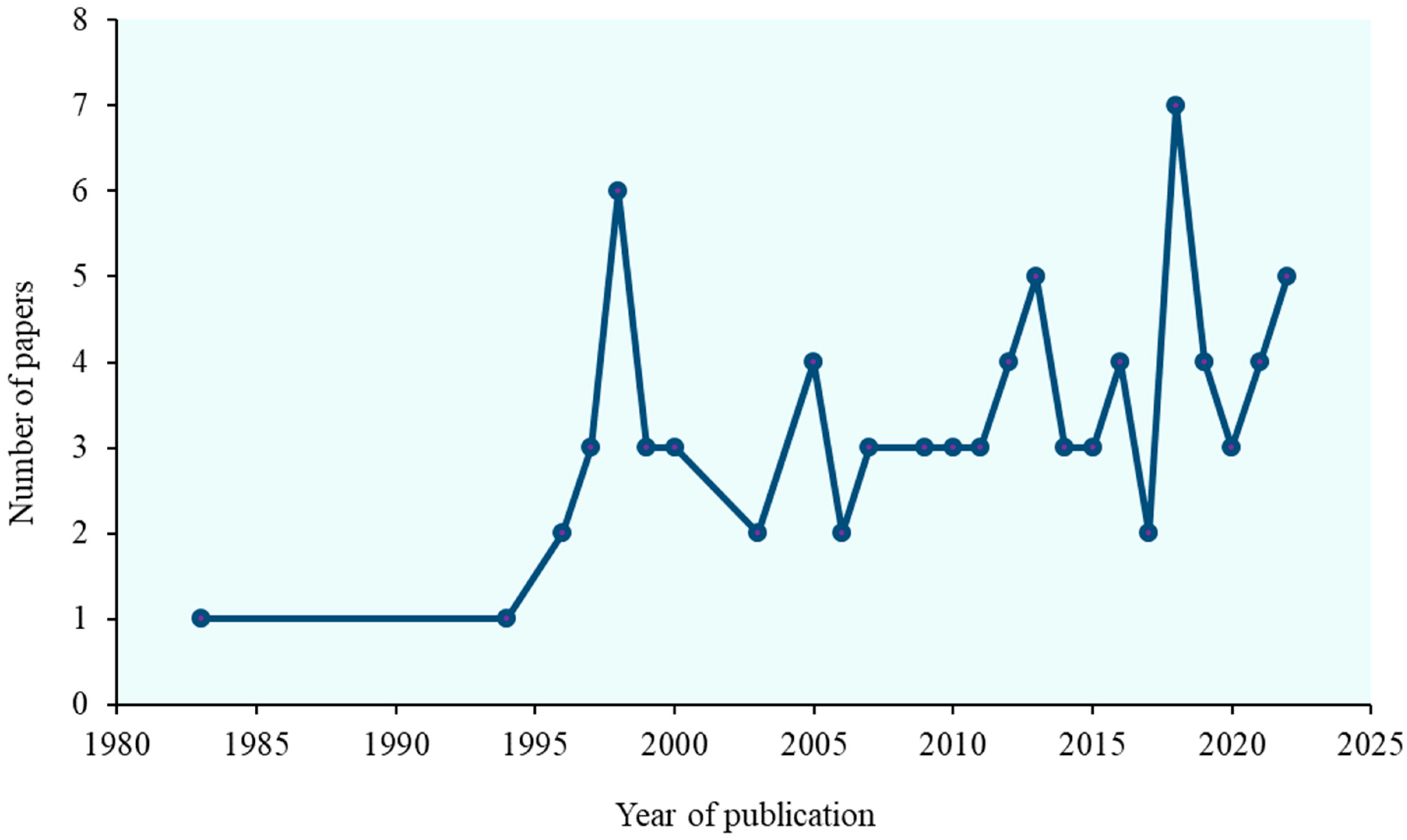


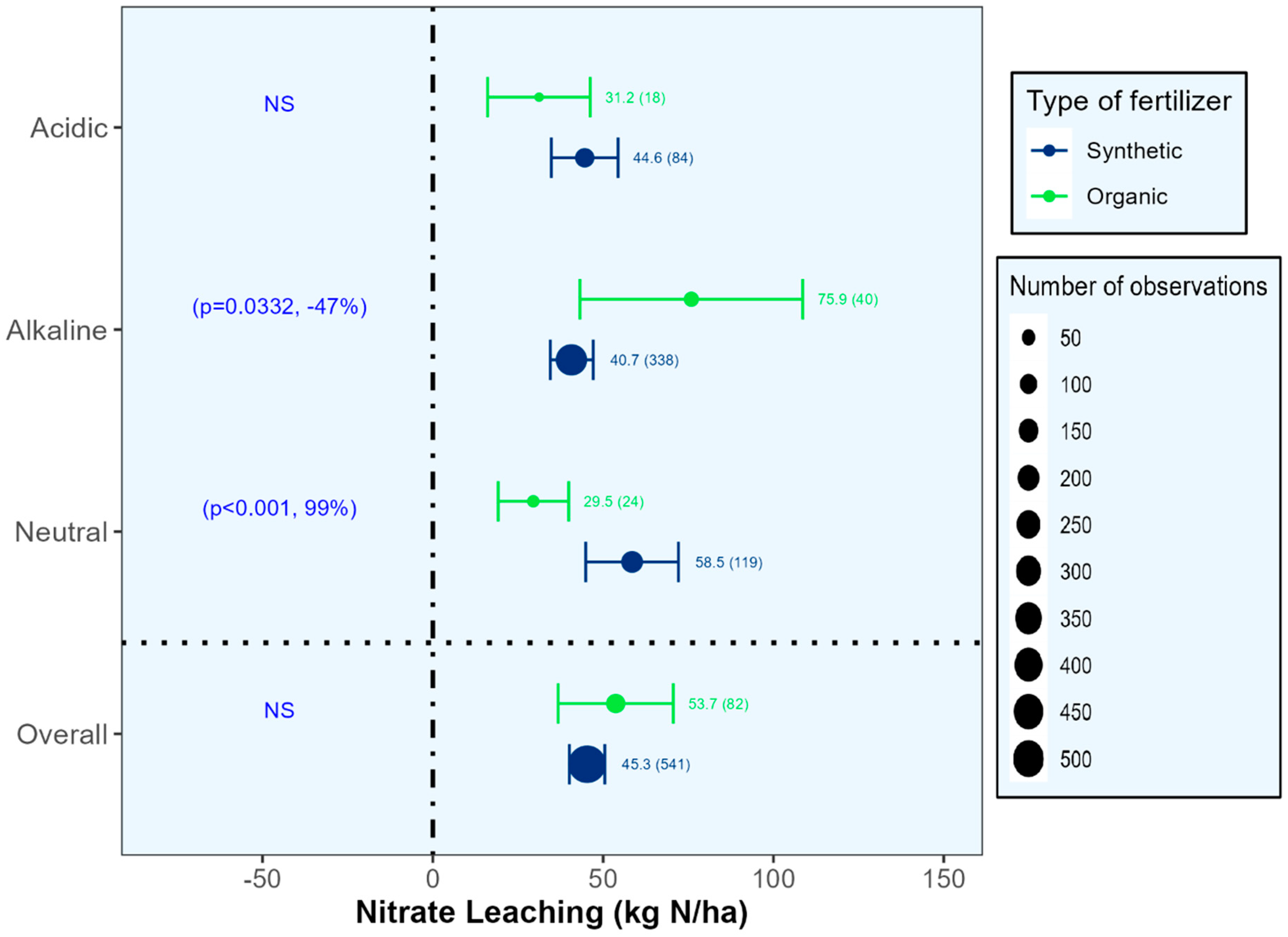
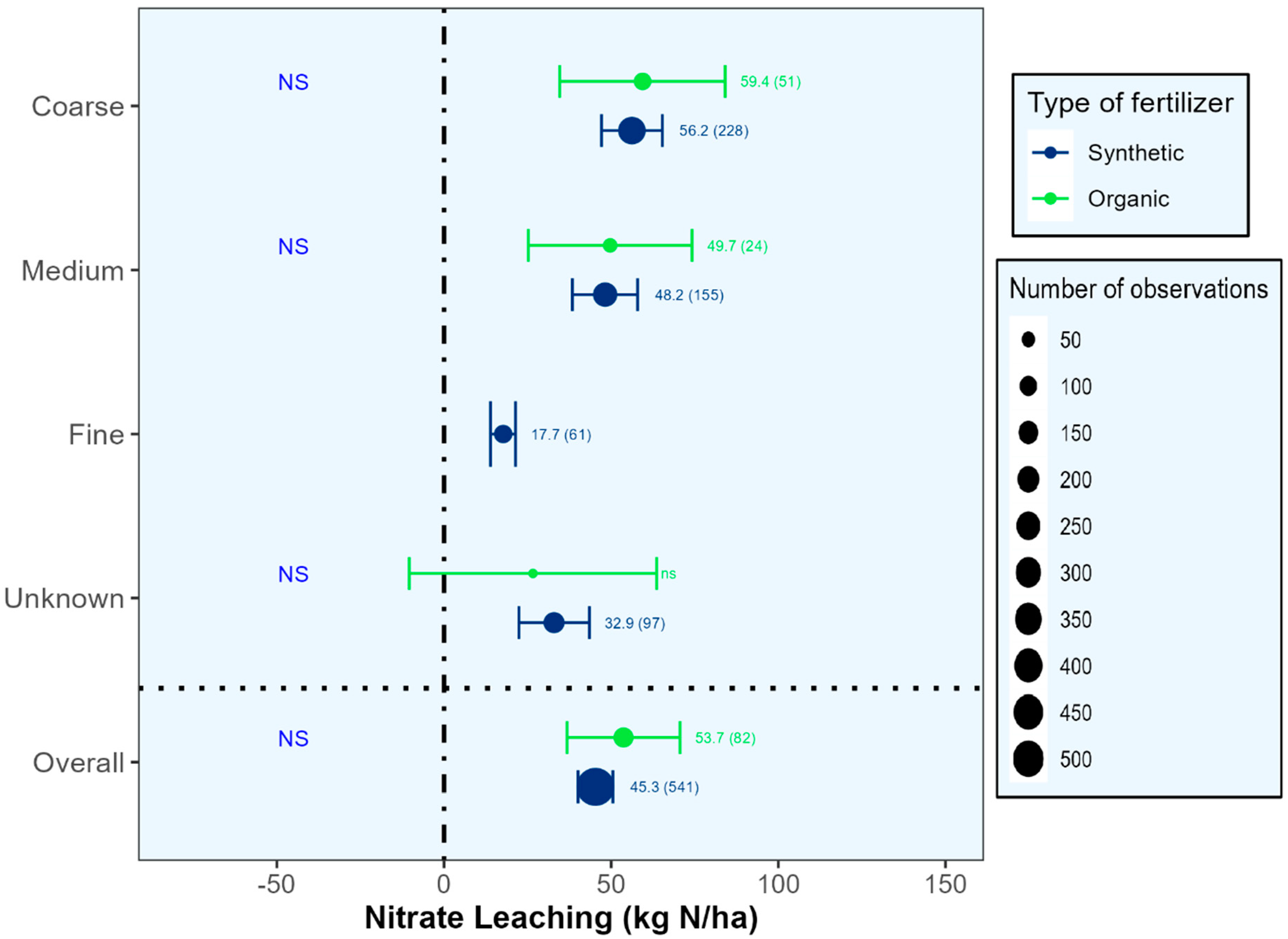

| Data Span | Treatments | Sub-Groups | Number of Studies, Observations | Output Parameters | Observations for N Leaching | Reference |
|---|---|---|---|---|---|---|
| 38 years (1969–2007) | Fate of N from grain crops | Soil order, soil texture, field plot size, soil organic C, and latitude and longitude of the experimental site | 217 studies | N pools and fluxes | 6 studies | [30] |
| 23 years (1990–2013) | Urine application rate | - | 12 studies, 82 observations | NO3−-N leaching | - | [27] |
| Published before March 2016 | Effect of N management on grain yield and N losses | Fertilisers N management, and N rate | 376 studies, 1166 observations | Grain yield, NUE, NH3 and N2O emission and N leaching and runoff | 4 observations | [31] |
| Published before August 2016 | Livestock manure | Manure type, crop type | 141 | Crop productivity, NH3 emission, N leaching and N run off | 61 observations | [32] |
| Published before October 2018 | N fertilizer rate | Crop type, fertilizer type, soil pH, total N, measuring method | 86 studies, 324 observations | Soil NO3−-N leaching emission factors | - | [28] |
| Published before 10 September 2020 | Effect of fertilizer types and application rate on vegetables | Fertilizer types and application rates | 477 observations | N2O emission and N leaching | 220 observations | [33] |
| Published before 11 January 2020 | Effect of crop residues | Climatic conditions, land use type, soil pH, soil texture, synthetic fertilizer application, crop residue type, tillage, and duration of experiment | 90 studies, 345 observations | NO3− leaching and N2O emission | 90 observations | [29] |
| Published between 1990 and 2021 | Effect of animal manure on crop productivity and reactive N losses | Reactive N, crop productivity, soil chemical properties, dissolve organic carbon | 334 studies | Crop productivity, NH3 and N2O emission, N leaching | - | [34] |
Disclaimer/Publisher’s Note: The statements, opinions and data contained in all publications are solely those of the individual author(s) and contributor(s) and not of MDPI and/or the editor(s). MDPI and/or the editor(s) disclaim responsibility for any injury to people or property resulting from any ideas, methods, instructions or products referred to in the content. |
© 2024 by the author. Licensee MDPI, Basel, Switzerland. This article is an open access article distributed under the terms and conditions of the Creative Commons Attribution (CC BY) license (https://creativecommons.org/licenses/by/4.0/).
Share and Cite
Hina, N.S. Global Meta-Analysis of Nitrate Leaching Vulnerability in Synthetic and Organic Fertilizers over the Past Four Decades. Water 2024, 16, 457. https://doi.org/10.3390/w16030457
Hina NS. Global Meta-Analysis of Nitrate Leaching Vulnerability in Synthetic and Organic Fertilizers over the Past Four Decades. Water. 2024; 16(3):457. https://doi.org/10.3390/w16030457
Chicago/Turabian StyleHina, Naila Sumreen. 2024. "Global Meta-Analysis of Nitrate Leaching Vulnerability in Synthetic and Organic Fertilizers over the Past Four Decades" Water 16, no. 3: 457. https://doi.org/10.3390/w16030457
APA StyleHina, N. S. (2024). Global Meta-Analysis of Nitrate Leaching Vulnerability in Synthetic and Organic Fertilizers over the Past Four Decades. Water, 16(3), 457. https://doi.org/10.3390/w16030457





